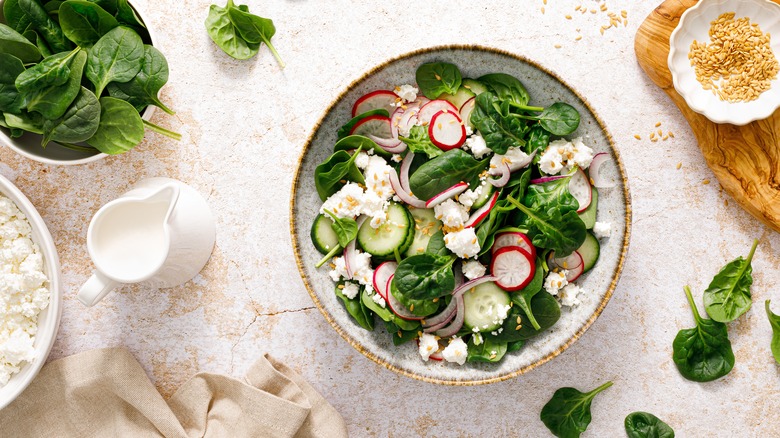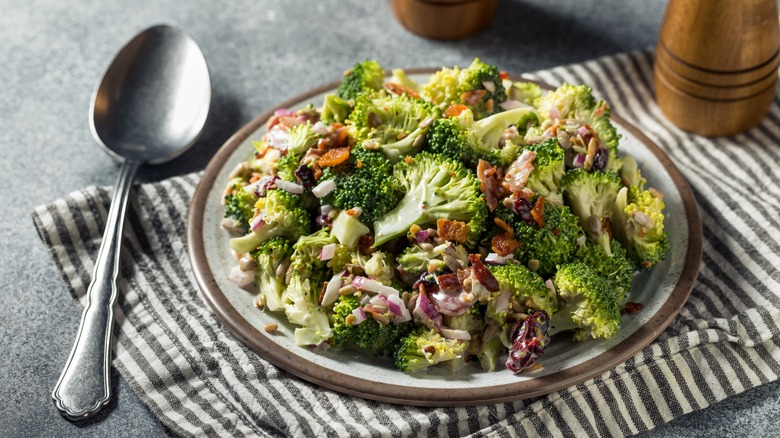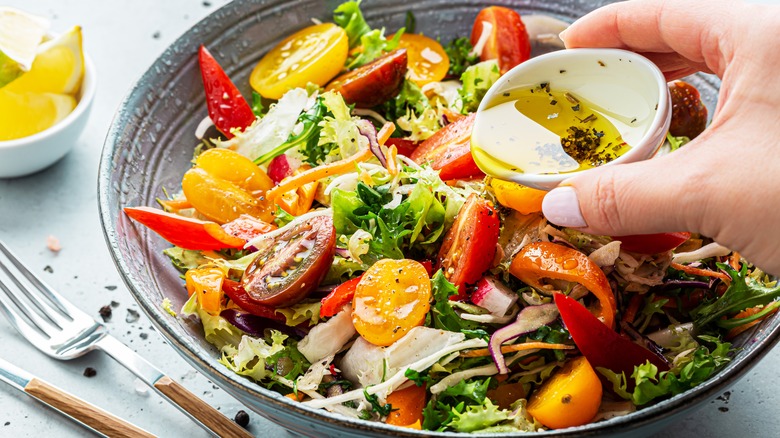Why Texture Is So Important For Restaurant-Quality Salads, According To A Chef
There are, unfortunately, a lot of sad salads in the world. Your instinct for making a salad at home may include piling leafy greens into a bowl with a chopped veggie or two and, if you're lucky, maybe a handful of croutons on top. Then, lather on the bottled salad dressing to sort of cover up the mess of vegetables. That's no way to enjoy eating your fresh greens! But when done right, a salad can be an exhilarating adventure for the palette.
Often, restaurant salads prepared by professional chefs contain unique ingredients or a delicate balance that you can't seem to recreate at home. And Camille Becerra, chef-partner at As You Are restaurant at the Ace Hotel in Brooklyn, NY, sure knows how to do a salad right. "What I prefer is that all ingredients have different textural qualities so I don't get palate exhaustion, meaning when each bite is the same bite after bite," Becerra shared with Daily Meal. Apply this logic to your own salad-making: Cover all your textural bases by incorporating ingredients that contrast each other.
One ingredient you may not need to make a great salad
If you start every salad-making endeavor the same way, by chopping up a head of lettuce, it may be time to rethink things and start from a different square one: texture. Take a page out of Camille Becerra's book. "I love a salad with no lettuce," she said. There is no hard and fast rule saying you must make lettuce the base of every salad. After all, the name 'salad' refers to something other than lettuce anyway, and that's salt.
While you can certainly swap in other leafy greens like kale or collard greens instead of lettuce, you can steer away from leaves entirely as well. Sturdy broccoli can hold up as a salad base underneath a thicker, creamier dressing and pairs beautifully with crunchy ingredients like almonds. Or chop crispy cucumbers with crunchy radishes for a bright salad that doesn't feel weighed down. And if you really want to bring the restaurant salad experience home, you can even use a cold bowl for a tastier salad.
Ingredient examples that bring textural contrast to your homemade salads
Instead of trying to achieve a perfect balance in every salad you make, it'd be a more fruitful effort to include a variety of ingredients with differing textures. "Ratios don't exist in salads outside of the dressing," Camille Becerra wisely shared with us. Essentially, while it's important to have a dressing balanced in sweetness, acidity, and fat, your salad can be a hodgepodge of whatever fruit and vegetables you like. As long as your ingredients each bring a unique textural element to the table, you'll be golden.
You can even upgrade a bagged salad by adding these texturally contrasting, fresher ingredients missing from a prepared bagged salad. For example, creamy avocado can offset the crunchy slaw or greens in any salad. Fresh, soft cheeses like mozzarella or crumbly feta are also wonderful creamy texture choices. And if you crave crispiness, look beyond the produce section and crumble up your favorite snack sitting in the pantry, like tortilla chips or crispy wontons. No matter what you choose, make sure you consider the ingredients' textures as Camille Becerra does, and you'll never suffer from a sad salad again.


